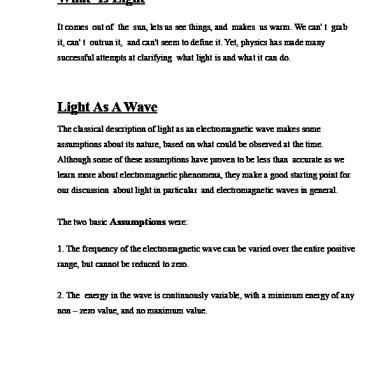Light 7thclass-project(adarsh Nagar)
This document was uploaded by user and they confirmed that they have the permission to share it. If you are author or own the copyright of this book, please report to us by using this DMCA report form. Report DMCA
Overview
Download & View Light 7thclass-project(adarsh Nagar) as PDF for free.
More details
- Words: 424
- Pages: 3
What Is Light It comes out of the sun, lets us see things, and makes us warm. We can' t grab it, can' t outrun it, and can't seem to define it. Yet, physics has made many successful attempts at clarifying what light is and what it can do.
Light As A Wave The classical description of light as an electromagnetic wave makes some assumptions about its nature, based on what could be observed at the time. Although some of these assumptions have proven to be less than accurate as we learn more about electromagnetic phenomena, they make a good starting point for our discussion about light in particular and electromagnetic waves in general. The two basic Assumptions were: 1. The frequency of the electromagnetic wave can be varied over the entire positive range, but cannot be reduced to zero. 2. The energy in the wave is continuously variable, with a minimum energy of any non – zero value, and no maximum value.
Light As A Particle Light behaves in some ways as if it consists of discrete particles rather than infinitely variable waves. These apparent particles have been designated photons.
Some of the characterstics are: 1.Any single photon has a fixed, discrete energy level. 2.Each color of light has its own unique energy level. It is not possible to increase or decrease the energy of that single photon without changing its wavelength, or else absorbing it completely and thereby ending its existence.
3.The intensity of visible light can be increased or decreased only by changing the number of photons present.
4.The same rules hold true for electromagnetic phenomena outside the visible range.
Conversions of light 1.Luminance conversions: is the amount of visible light leaving a point on a
surface in a given direction. It is usually used to convert between different units such as candela / square meter, lumen / square meter, nit, lambert, bril, skot, and more. 2.Illumination conversions : is the total amount of visible light illuminating a point on a surface from all directions above the surface. It is usually used to convert between different units such as lux, flame, phot, nox , lumen / sqare meter,meter- candle, and more. 3.Luminous Intensity: is the luminous flux emitted from a point per unit solid angle into a particular direction. It is usually used to convert between different units such as candle, pentane candle, hefner candle, lumen / steradian, and more.
Devolped By: Govt. Girls Sec. School,Adarsh Nagar,Jal. Bibliography: 1 www.thefreedictionary.com/light 2 wordnet.princeton.edu/perl/webwn
Student's Name : 1. Jagjeet 2. Amandeep 3. Harpreet
Light As A Wave The classical description of light as an electromagnetic wave makes some assumptions about its nature, based on what could be observed at the time. Although some of these assumptions have proven to be less than accurate as we learn more about electromagnetic phenomena, they make a good starting point for our discussion about light in particular and electromagnetic waves in general. The two basic Assumptions were: 1. The frequency of the electromagnetic wave can be varied over the entire positive range, but cannot be reduced to zero. 2. The energy in the wave is continuously variable, with a minimum energy of any non – zero value, and no maximum value.
Light As A Particle Light behaves in some ways as if it consists of discrete particles rather than infinitely variable waves. These apparent particles have been designated photons.
Some of the characterstics are: 1.Any single photon has a fixed, discrete energy level. 2.Each color of light has its own unique energy level. It is not possible to increase or decrease the energy of that single photon without changing its wavelength, or else absorbing it completely and thereby ending its existence.
3.The intensity of visible light can be increased or decreased only by changing the number of photons present.
4.The same rules hold true for electromagnetic phenomena outside the visible range.
Conversions of light 1.Luminance conversions: is the amount of visible light leaving a point on a
surface in a given direction. It is usually used to convert between different units such as candela / square meter, lumen / square meter, nit, lambert, bril, skot, and more. 2.Illumination conversions : is the total amount of visible light illuminating a point on a surface from all directions above the surface. It is usually used to convert between different units such as lux, flame, phot, nox , lumen / sqare meter,meter- candle, and more. 3.Luminous Intensity: is the luminous flux emitted from a point per unit solid angle into a particular direction. It is usually used to convert between different units such as candle, pentane candle, hefner candle, lumen / steradian, and more.
Devolped By: Govt. Girls Sec. School,Adarsh Nagar,Jal. Bibliography: 1 www.thefreedictionary.com/light 2 wordnet.princeton.edu/perl/webwn
Student's Name : 1. Jagjeet 2. Amandeep 3. Harpreet





